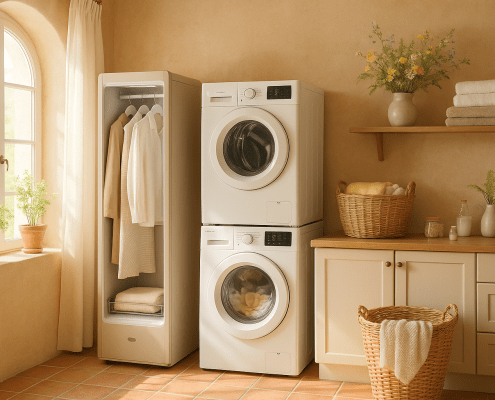8 Most Common Laundry Steam Closet Mistakes and How to Avoid Them
Steven E / Monday July 14, 2025
Steam closets are a game-changer for keeping clothes fresh and wrinkle-free, but only if you use them right. A few common mistakes can hurt your results (and your closet). Here are the most common user mistakes with steam closets and how to avoid them to get the best results from your appliance.
Why Proper Steam Closet Use Matters
Steam closets are designed to handle specific types of fabrics and operate under precise conditions. Using the appliance the wrong way can lead to problems such as:
- Excessive water pooling inside
- Mineral buildup in the steam generator
- Clothes that remain damp or improperly de-wrinkled
- Malfunctioning sensors and parts
- Unpleasant odors over time
By using your steam closet the way it was designed, you can avoid these issues and enjoy consistently great results.
1. Overloading the Steam Closet
One of the most common mistakes is stuffing too many garments inside at once. While it might seem efficient to load as much as possible, overloading reduces airflow and steam distribution, leaving clothes poorly steamed.
How to avoid it
- Follow the manufacturer’s recommended load capacity.
- Leave space between each garment so steam can reach all surfaces.
- Use the included hangers or hooks correctly, and avoid clumping items together.
Not only will this improve the results, but it will also prevent excess strain on the closet’s fan and heating parts.
2. Using the Wrong Water
Steam closets rely on water to create the steam that freshens your clothes. Many users fill the water tank with tap water, but depending on where you live, this could be a big mistake. It’s easy to assume any water will do, but tap water often contains minerals that build up inside the steam generator and water lines over time. This can lead to clogs, reduced performance, or strange odors.
How to avoid it
- Use distilled or demineralized water whenever possible. This prevents mineral deposits and keeps the internal parts clean.
- If you must use tap water, clean and descale the water system more frequently.
3. Leaving Clothes Inside Too Long
Another frequent mistake is leaving clothes hanging in the steam closet hours after the cycle finishes. Life gets busy, and it’s easy to forget about the clothes once the cycle ends. Leaving clothes too long can also trap residual moisture in the closet, which can contribute to mold or mildew if it becomes a habit.
How to avoid it
- Remove garments promptly when the cycle is complete to prevent dampness and odors.
- If clothes are left too long and become wrinkled again, simply run a short touch-up cycle.
- Consider setting a timer or alarm to remind you to take clothes out right away.
4. Ignoring Regular Cleaning
Since the appliance uses steam, it feels self-cleaning. However, water and fabric fibers leave behind residue over time.
How to avoid it
- Wipe down the interior surfaces weekly with a dry cloth to remove moisture and lint.
- Clean the drain filter regularly to prevent clogs.
- Run a descaling cycle monthly, or according to the manufacturer’s instructions, especially if you use tap water.
- Leave the door slightly ajar between uses to help it dry out completely.
5. Placing the Steam Closet on an Uneven Surface
An uneven floor can cause water to pool unevenly in the bottom of the steam closet and interfere with proper drainage. Keeping the unit level ensures that water drains properly and helps prevent leaks and internal water damage.
How to avoid it
- Use a level to check that the steam closet is perfectly upright.
- Adjust the leveling feet on the bottom of the unit if it’s tilted.
- Avoid placing it on thick carpet or soft flooring that might sag under its weight.
6. Blocking the Airflow
For a steam closet to work properly, it needs adequate airflow both inside and outside. Blocking the vents or crowding the interior can interfere with operation. People often tuck the steam closet into a tight space without leaving room for ventilation. Proper airflow helps steam circulate and ensures sensors can accurately monitor humidity and temperature.
How to avoid it
- Place the steam closet at least a few inches away from walls or cabinets.
- Don’t cover or block the exterior vents.
- Don’t hang garments directly over the interior sensors or fans.
7. Running It Without Checking the Water Tank
Running out of water mid-cycle can leave clothes wrinkled and may trigger error codes. This can also result in clothes that are barely steamed and can even trip safety sensors.
How to avoid it
- Check the water level every time before starting a cycle.
- Make it part of your routine, just like checking the lint trap on a dryer.
- Refill the tank with clean water before each use if it’s low.
8. Using the Wrong Settings for Fabric Types
Steam closets often come with a variety of settings for different fabric types. Using the wrong one can lead to over-steaming delicate fabrics or under-treating heavier ones.
How to avoid it
- Take a moment to select the appropriate cycle for the type of fabric you’re steaming.
- Use gentler cycles for silks and delicate items.
- Use longer, hotter cycles for cottons and heavier fabrics.
- Read the labels on your garments to guide your choices.
Where To Find Us
If you need any replacement parts for your appliances, you can enter your model number at AppliancePartsPros.com to locate and order them quickly. Most orders arrive in just two business days, and we have tons of great information in our repair help section and YouTube videos to help you troubleshoot.
Stay connected with the latest DIY tips, tutorial videos, and repair guides by following us on Facebook, Instagram, and Twitter. We love hearing about your repair stories and successes. If you need more help or want personalized guidance, feel free to reach out. We’re ready to help you take on your next project with confidence!
The information in this article may not apply to your specific appliance model. We recommend consulting your manufacturer’s documentation or contact us with any questions.
With nearly a decade of experience in providing top-notch customer service regarding appliance parts and repair, Steven enjoys sharing practical advice, troubleshooting tips, and interesting information to help readers stay informed.





